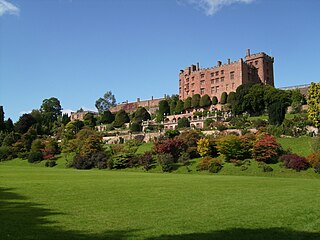The Register

- 1. Clwyd-Powys
- 2. Dyfed
- 3. Glamorgan-Gwent
- 4. Gwynedd
The register was complied as part of a joint initiative that involved Cadw, the Countryside Council for Wales (CCW) and the International Council on Monuments and Sites working in collaboration with Welsh unitary authorities, the Royal Commission on the Ancient and Historical Monuments of Wales and the Welsh Archaeological Trusts (WATs). [3] [4] [5] The four trusts, Clwyd-Pows, Dyfed, Glamorgan-Gwent and Gwynedd, each cover an area of Wales based on the 1974 county areas. [6] The first volume of the register, Part 2.1 Register of Landscapes of Outstanding Historic Interest in Wales, [lower-alpha 3] was published in January 1998 and listed 36 "outstanding" landscapes (numbered 1–36 on the list). It was followed in 2001 by a second volume, Part 2.2 Register of Landscapes of Special Historic Interest in Wales, which identified a further 22 landscapes of "special" historic interest (numbers 37–58). These 22 areas of national significance are generally smaller than those of outstanding historic interest identified in the first volume. [3] [4] [5] [8] The CCW website gives five criteria used for identifying the historic landscapes on the register: [9]
- Landscapes which have been changed in major ways showing human endeavour on a grand scale, including cities, conurbations, industrial areas and civil engineering projects.
- Landscapes which show change during a particular period and where change has since stopped.
- Landscapes which show the effect of changes over several periods, including a range of different features or different versions of the same feature.
- Landscapes where historical evidence has been buried or lost.
- Landscapes which have 'cultural merit' – through links with important cultural trends or achievements.
The "special" landscapes often match a single criterion, whereas the "outstanding" landscapes may represent one or more of them. [9] Both types are considered to be of equal value in terms quality of historic interest and Cadw notes that the register highlights the best examples, but "does not reduce the importance of the rest of Wales’s rich historic landscape". [7] [10] The distinction between the two volumes has been described as the equivalent of Grade I and II designations used in other Welsh heritage registers, [11] however, the register is non-statutory so, unlike National parks and Areas of Outstanding Natural Beauty, the landscapes have no special protection, [12] though several registered historic landscapes share geographic areas with the protected sites, for example in the Gower Peninsula. [13] [14]
Historic landscape characterisation
The initial research for the publication of the register was expanded with a further initiative to produce a collection of detailed landscape reports, compiled by the WATs with grant aid from Cadw. This used a process developed by Cadw, the CCW and the WATs known as historic landscape characterisation. The development of this technique included methods introduced through research studies of the Llŷn Peninsula and the Gwent Levels, and it was used to describe geographic areas of historic character based on factors including the range and distribution of surviving archaeological and historical features. [3] [4] [5] [15] [16] The register was aimed at increasing recognition of the value of historic landscapes, and raising awareness of their importance. The register and the reports were seen as the first steps in a larger project of historic landscape characterisation used to identify the characteristics of the areas. The reports are used to inform recommendations for managing, rather than preventing, changes to the landscape, and were complied with the intention that they would be compatible with the CCW's LANDMAP system and could be used to enhance rural initiatives such as the Tir Gofal agri-environment scheme. [3] [4] [5] [17]










